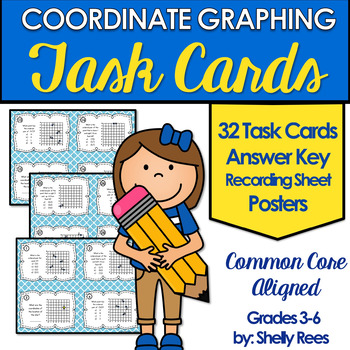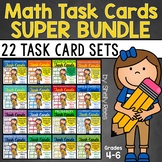Coordinate Points on a Graph Task Cards and Posters Set
Shelly Rees
53.8k Followers
Grade Levels
3rd - 6th, Homeschool
Subjects
Resource Type
Standards
CCSS5.G.A.1
CCSS5.G.A.2
Formats Included
- PDF
Pages
16 pages
Shelly Rees
53.8k Followers
Also included in
- Do your students LOVE task cards? Are you looking for a great way to add variety and solid reinforcement to math skill practice in your classroom? This Math Task Card Bundle is just what you need! This is a bundle of all 22 sets of my Math Task Card and Poster Sets. By purchasing this bundle, you aPrice $68.17Original Price $75.75Save $7.58
Description
Graphing points on a coordinate plane can be an easy concept for students to master, with appropriate practice! The product is perfect for reinforcing and practicing the skill of coordinate graphing. This set of Task Cards and Posters also works well for differentiating instruction in grades 4 and 6.
Click here and SAVE by buying the Complete Bundle of Math Task Cards for Grades 4-6.
This helpful packet includes:
• Common Core Standard Posters
• Common Core “I Can” Posters
• Graphing Coordinate Points Example Poster
• 32 Task Cards (28 on level and 4 challenge)
• Answer Key
• Student Answer Worksheet
The posters and examples are perfect for placement in student math journals. Just copy in a reduced size (2-4 posters per page works well) and have students place into their notebooks.
The cards work best when printed on cardstock. Cut cards and laminate. Use in Math Centers, as individual work, or for early finishers. I have also found my students love to complete the task cards in a game format, such as Scoot! Cards #1-28 are on-level, while cards #29-32 are challenge tasks.
This product is a great companion to my:
Coordinate Grids and Ordered Pairs Math Packet (5th Grade Common Core Math: 5.G.1)
Graphs & Real World Problems Math Packet (5th Grade Common Core Math: 5.G.1 and 5.G.2)
Check out these other great Task Card and Poster Sets:
Numerical Patterns Task Card and Poster Set
Measurement Conversion Task Card and Poster Set
Probability Task Card and Poster Set
2-Dimensional Shape Classification Task Card and Poster Set
Mean, Median, Mode, and Range Task Card and Poster Set
Numerical Expressions, Order of Operations Task Card and Poster Set
Elapsed Time Task Card and Poster Set
Fraction Multiplication Task Card and Poster Set
3-Dimensional Shapes and Volume Task Card and Poster Set
Decimal Comparison and Number Form Task Card and Poster Set
Multiplication of Whole Numbers Task Card and Poster Set
Fraction Division Task Card and Poster Set
Division of Whole Numbers Task Card and Poster Set
Don't forget that leaving feedback earns you points toward FREE TPT purchases. I love that feedback!
Also, FOLLOW ME and be notified when new products are uploaded. New products are always 50% off for the first 24 hours they are posted. It pays to follow me!
As always, please contact me with any questions!
Thank you so much,
Shelly Rees
Click here and SAVE by buying the Complete Bundle of Math Task Cards for Grades 4-6.
This helpful packet includes:
• Common Core Standard Posters
• Common Core “I Can” Posters
• Graphing Coordinate Points Example Poster
• 32 Task Cards (28 on level and 4 challenge)
• Answer Key
• Student Answer Worksheet
The posters and examples are perfect for placement in student math journals. Just copy in a reduced size (2-4 posters per page works well) and have students place into their notebooks.
The cards work best when printed on cardstock. Cut cards and laminate. Use in Math Centers, as individual work, or for early finishers. I have also found my students love to complete the task cards in a game format, such as Scoot! Cards #1-28 are on-level, while cards #29-32 are challenge tasks.
This product is a great companion to my:
Coordinate Grids and Ordered Pairs Math Packet (5th Grade Common Core Math: 5.G.1)
Graphs & Real World Problems Math Packet (5th Grade Common Core Math: 5.G.1 and 5.G.2)
Check out these other great Task Card and Poster Sets:
Numerical Patterns Task Card and Poster Set
Measurement Conversion Task Card and Poster Set
Probability Task Card and Poster Set
2-Dimensional Shape Classification Task Card and Poster Set
Mean, Median, Mode, and Range Task Card and Poster Set
Numerical Expressions, Order of Operations Task Card and Poster Set
Elapsed Time Task Card and Poster Set
Fraction Multiplication Task Card and Poster Set
3-Dimensional Shapes and Volume Task Card and Poster Set
Decimal Comparison and Number Form Task Card and Poster Set
Multiplication of Whole Numbers Task Card and Poster Set
Fraction Division Task Card and Poster Set
Division of Whole Numbers Task Card and Poster Set
Don't forget that leaving feedback earns you points toward FREE TPT purchases. I love that feedback!
Also, FOLLOW ME and be notified when new products are uploaded. New products are always 50% off for the first 24 hours they are posted. It pays to follow me!
As always, please contact me with any questions!
Thank you so much,
Shelly Rees
Total Pages
16 pages
Answer Key
Included
Teaching Duration
N/A
Report this resource to TPT
Reported resources will be reviewed by our team. Report this resource to let us know if this resource violates TPT’s content guidelines.
Standards
to see state-specific standards (only available in the US).
CCSS5.G.A.1
Use a pair of perpendicular number lines, called axes, to define a coordinate system, with the intersection of the lines (the origin) arranged to coincide with the 0 on each line and a given point in the plane located by using an ordered pair of numbers, called its coordinates. Understand that the first number indicates how far to travel from the origin in the direction of one axis, and the second number indicates how far to travel in the direction of the second axis, with the convention that the names of the two axes and the coordinates correspond (e.g., 𝘹-axis and 𝘹-coordinate, 𝘺-axis and 𝘺-coordinate).
CCSS5.G.A.2
Represent real world and mathematical problems by graphing points in the first quadrant of the coordinate plane, and interpret coordinate values of points in the context of the situation.






